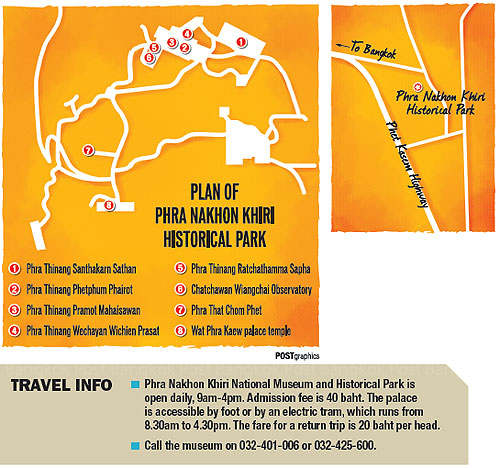Anyone travelling to the south of Thailand by car or bus must have noticed a palace atop a mountain at the entrance of Phetchaburi town along Phetkasem Road. Many Thais know this place as Khao Wang, but not all of them have visited the summer palace of King Rama IV, or King Mongkut, and even known its full name, Phra Nakhon Khiri.
Phra Nakhon Khiri was constructed on Mahasawan Mountain between 1859-1860 on the order of King Rama IV, under the supervision of Somdet Chao Phraya Borom Maha Srisuriyawong (Chuang Bunnag) and Phra Phetpisai (Thuam Bunnag). It is in neo-classic style with some Thai and Chinese influences. The complex is divided into three main parts built on three mountain peaks — the residential palace in the west, the main stupa in the middle and a temple called Wat Phra Kaew in the east. It was frequented by King Rama IV and King Rama V for leisure and royal visits.
According to the Fine Arts Depatment's book Phra Nakhon Khiri Historical Park, the arrangement of the structures in harmony with the mountainous landscape reflects King Rama IV's excellent understanding of architecture and his architects' construction abilities. All palatial, religious and citadel structures and pavilions are laid out on mountain peaks and connected to one another along the slopes. Each building is designed to suit its purpose. For example, the Chatchawan Wiangchai Observatory has a dome-shaped glass roof and verandah around the base, which are suitable for the installation of telescopes.

Phra Nakhon Khiri, or Khao Wang, is Thailand’s first palace complex constructed on a mountain. Located on Mahasawan Mountain, which is 95m above sea level, a majority of the buildings at Phra Nakhon Khiri are not constructed in traditional fashion, but in a harmonious mixed style, which blends foreign elements. The palace buildings were constructed on a rectangular plan, which is typical Thai, but have arched windows and doors in the Western style. The buildings are covered with Chinese tiles called krabuang kab kluay and put together with plaster. Local materials were applied, such as the use of stucco motifs of the Phetchaburi craftsmen, old-style plaster wall surfaces and baked clay tiles.
Phra Nakhon Khiri flourished during the reign of King Rama IV. When the king was a monk before his accession to the throne, he went to practice meditation in Khao Yoi district and spent several days at Wat Maha Samanaram on the slope of this mountain. The king and his entourage travelled to the palace by boat to the mouth of the Phetchaburi River in tambon Ban Laem and by horse-drawn carriages from Ban Laem.
American missionary Dan Beach Bradley wrote accounts on King Rama IV and King Rama V's visits to Khao Wang.
For instance, on May 10, 1860, King Mongkut made his second visit to Phetchaburi to inspect the construction of the palace. On Nov 12, 1861, he went to the palace for a stay. In the same year, he wrote to his son Prince Khakkhanang Yugala, who was staying at Phra Nakhon Khiri, and advised him to provide vehicles for a visiting envoy sent by the King of Prussia and see him off to a ship.
On the birthdays of King Rama IV, the palace was decorated with flags and an offering table was set up in Phra Thinang Phetphum Phairot Hall. Annual celebrations lasted for three days.
The palace was still visited by King Rama V in the early 1880s, but was left in decay after his reign. Fortunately, it was registered by the Fine Arts Department as a national monument in 1935 and has been restored since then to serve as a national museum and historical park.
Phra Nakhon Khiri is a must-see for anyone travelling to Phetchaburi besides visiting several temples, Mrigadayawan and Phra Ram Ratchaniwes palaces and tasting the town's famous khao chae (rice in fragrant iced water eaten with sweetened fish, pork and radish and other dishes) and local desserts, especially khanom mor kaeng (Thai-style custard).

Phra Thinang Wechayan Wichien Prasat is a pavilion in the Prasat style with a Prang-style roof with five spires — the tallest and biggest corncob top in the middle and four projections at the sides. It is adorned with stucco mouldings standing on a three-tiered base. Inside the building is a statue of King Rama IV in the standing posture wearing his traditional outfit for receiving foreign envoys — a long-sleeved top, jongkraben, waistband and a round Scottish-style beret — and holding a sword in his right hand and a book in his left.

Phra Thinang Ratchathamma Sapha is a single-storey hall located in between Phra Thinang Wechayan Wichien Prasat and Phra Thinang Phetphum Phairot. The building resembles a Chinese house, but has arched windows and doors with round pilasters in bas-relief in between them. The capitals look like the Ionic order of Greek architecture. On the top of each capital is a globular vase holding a blooming plant in bas-relief. King Rama IV used this hall to gather courtiers and officials to listen to Lord Buddha’s teachings briefed by himself after he had listened to sermons by monks each day. The king had long been a monk before becoming a king. Later in the reign of King Rama V, the building was converted into a dining room for royals.

Situated in front of Phra Thinang Ratchathamma Sapha, Chatchawan Wiangchai Observatory, or the Glass Dome, was where King Rama IV observed stars and constellations. This round building boasts winding steps leading to the top. The lower balustrades are decorated with Chinese-made green glazed ceramic rails. The doom-shaped roof is made of glass. King Rama IV excelled in astronomy and correctly forecast a total solar eclipse in Ban Wah Kor, Prachuap Khiri Khan, two years ahead of the phenomenon, which occurred at 11.42am on Aug 18, 1868.








